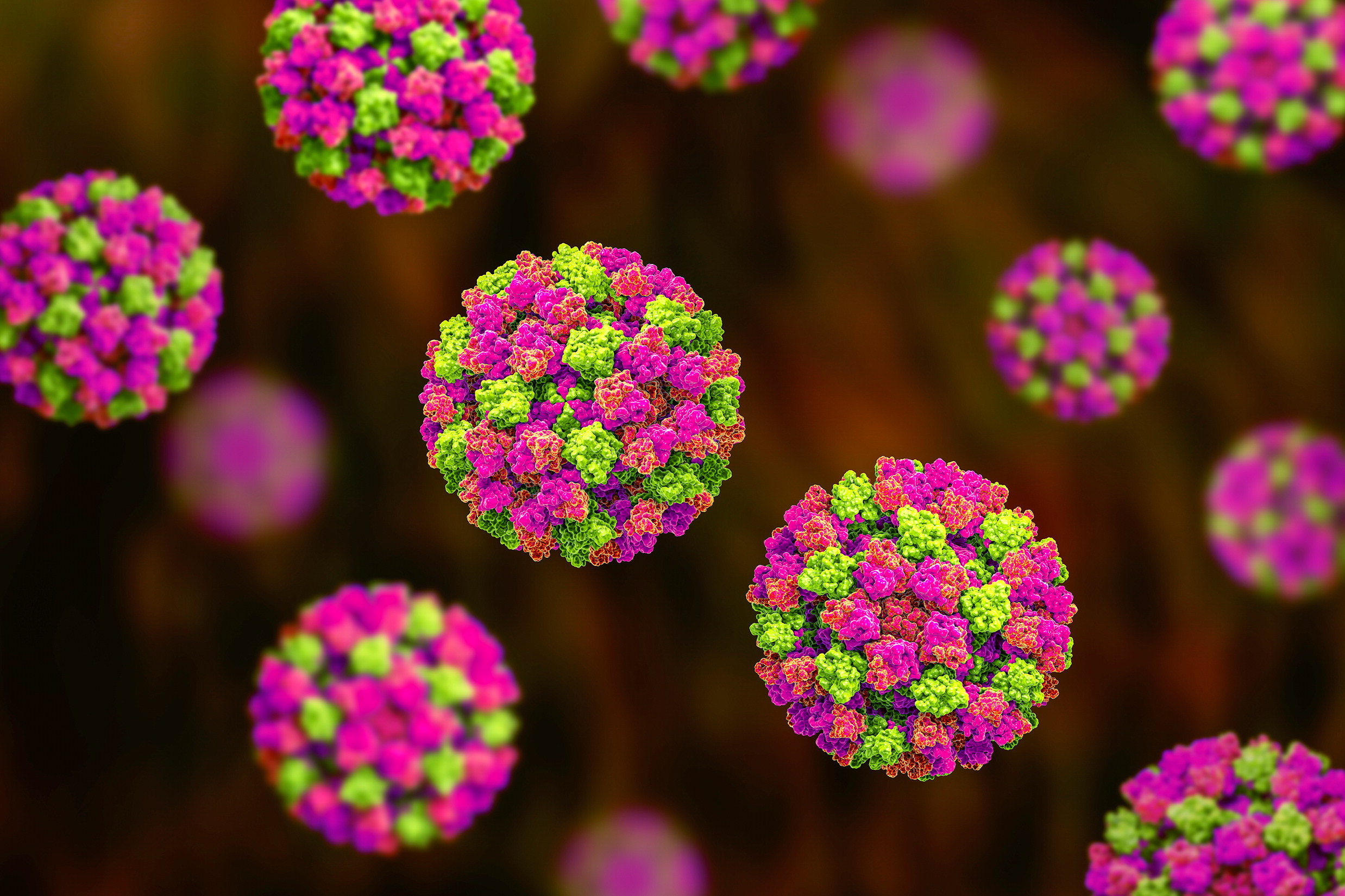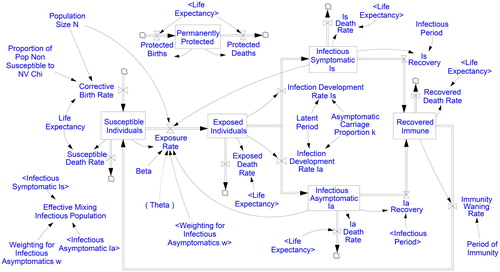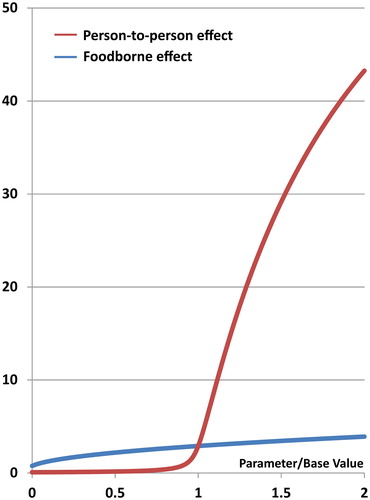Abstract
IF, LIKE THE AUTHOR, YOU HAVE EVER SUFFERED FROM NOROVIRUS, also known as the winter vomiting bug, you will know how debilitating it is. The symptoms of explosive vomiting, diarrhoea, headaches and fever cause misery, particularly when the virus breaks out in a confined location such as a cruise ship or hospital. It’s estimated that each year about 3 million infections occur in the UK; worldwide there are between 500 and 1,000 million cases, resulting in over 200,000 deaths, particularly among the weak and vulnerable. In crude financial terms, there are annual global costs of around $60 billion (£80 million in the UK alone). Getting a better understanding of the different routes by which the disease spreads offers a real hope of improved prevention.
FOODBORNE OR PERSON TO PERSON

My own infection was blamed on a hotel breakfast, but norovirus is particularly good at finding ways to contaminate people and there are plenty of options available. In practice, norovirus is more commonly spread directly from person to person, but there has been a relatively poor understanding of foodborne routes, which is why the UK’s Food Standards Agency (FSA) commissioned an Operational Research study to model the transmission methods in the hope of better targeting of interventions.
norovirus is more commonly spread directly from person to person, but there has been a relatively poor understanding of foodborne routes
David Lane, an Operational Research expert from Henley Business School, worked alongside colleague Elke Husemann, and Darren Holland and Abdul Khaled from the FSA, to model the transmission mechanisms. Lane is Professor of Business Informatics at Henley Business School, with mathematics degrees from Bristol and Oxford and a doctorate in mathematical modelling from Oxford, after which he moved on to oil company Shell. The work here involved Operational Research techniques, and Lane enjoyed the challenges, but after a few years wanted an opportunity to have time to develop new approaches. The result was a move back to academia, but with a practical edge gained from his experience.
Lane notes: ‘I haven’t really looked back – though perhaps the main development has been my attitude to teaching. Pretty quickly I found teaching very fulfilling and seeing it as a privilege to be able to work with clever young people, talking about things that enthuse me and trying to enthuse them, all the time watching them get better and make the best of what is inside them. It’s a joy.’ The theoretical/practical mix continues, as is clear in this project.
Norovirus itself is a tiny bug from the family Caliciviridae, around 30-nm long. Like all viruses, norovirus is not a complete living organism, but makes use of the molecular machinery within its host’s cells to reproduce, damaging the cells in the process. Norovirus is not treatable using antibiotics and spreads from person to person when as few as ten individual virus particles make their way into a new host, usually via vomit or faeces. Direct transmission can take place through physical contact with a victim, touching a contaminated surface or when the virus particles become airborne.
However, norovirus is hardy and can survive for a considerable period of time away from a host. As a result, it can also be spread via secondary routes through food and water. Some involve contact of a human carrier with the foodstuff, but mechanisms can also be surprisingly indirect. For example, norovirus particles in sewage can be ingested by shellfish which if eaten uncooked, pass the virus onto a new host.
SYSTEM DYNAMICS
The approach taken by the researchers was System Dynamics (SD). This technique, devised at the Massachusetts Institute of Technology by Jay Forrester in the 1950s, uses engineering-style thinking, in a highly creative manner, to simulate business and socioeconomic systems. David Lane: ‘SD is a computer simulation modelling approach which helps users understand the complex behaviours that systems produce over time, with a particular emphasis on the consequences of different policies.’
The team used a common structuring of potential sufferers known as SEIR: susceptible, exposed, infectious and recovered. Their model pulls together the different pathways by which the virus can be transmitted and, where possible, allocates numerical values to compare the risks from different infection routes. The FSA was initially doubtful that the data existed to make the model fully viable, but it was hoped that it would give a better understanding of the opportunities for mitigation, as well as indicating where further research was required.
The direct P2P (person to person) aspect of norovirus transmission had already been mapped out by a previous research project commissioned by the FSA in 2004, so it was possible to incorporate an updated version of this structure into the new model, constructed using the software Vensim. This product makes use of the standard SD concepts of stock (for example, levels of money or commodities) and flow (transfer of stock contents from place to place).
Systems Dynamics is a computer simulation modelling approach which helps users understand the complex behaviours that systems produce over time, with a particular emphasis on the consequences of different policies
An example of the stock and flow aspects of the P2P transmission is shown in , where we see the influences on and connections between individuals in the different states. A number of parameters feed into this, including ‘Beta’, which is the number of social encounters a susceptible person engages in which could result in exposure should they encounter an infectious person. There are also tweaking mechanisms such as the ‘Weighting for Infectious Asymptomatics’. This reflects the number of those infected with norovirus but not showing the symptoms, who will shed virus particles and potentially infect others.
In , a term ‘Theta’ feeds into the exposure rate: this was a catch-all in the earlier study to deal with situations when the virus is delivered via food. The aim of the new study was to replace Theta with a detailed model of foodborne routes that the virus could take from infected person to a new host. To build the model, the researchers started with a literature review and created simple models, then in an iterative process with experts from the FSA and other health bodies enhanced the model for each possible sector of foodborne transmission.
After interviews, discussions and sharing of the developing models with the experts, a final facilitated workshop was used to discuss functionality and provide feedback. Part of the importance of this process was buy-in from the clients. Rather than just being presented with results, the participants were involved throughout to ensure that they were happy with the models, could provide corrections and were able to feel that they supported the outcomes.
In putting the model together, four different foodborne sectors were identified:
the contamination of shellfish by virus-carrying sewage discharged into the ocean;
contamination of fruits, salads and leafy vegetables from ‘sludge’ – processed sewage used as fertiliser;
contamination in the supply chain of this kind of produce eaten uncooked (e.g., from workers on the farm or packers);
transport by other foodstuffs contaminated during their production, for example food handled by infected kitchen workers.
In both final sectors, infections in the home and commercial kitchens were separated. Each sector had its own stock and flow diagrams – shows the bivalve shellfish sector.
IMPROVING THE ESTIMATES
One of the useful outcomes of the process was being able to divide the parameters in the model – the values input to make it run – into four categories shown in . One dimension here is whether a parameter is fixed – that is not capable of being altered as a preventative measure – such as the population – or whether it can be changed by taking precautions. The second dimension was whether the value was currently known or unknown, highlighting opportunities for further research. Darren Holland from the FSA commented that the study ‘produced a whole list of knowledge gaps which would be needed to be filled to run the model properly and understand the issue further.’
TABLE 1 A 2 × 2 ORGANISING FRAMEWORK FOR THE PARAMETERS IN THE MODEL
A second important result was getting a better feel for the relative scale of P2P and foodborne routes of infection. This was one of three key parameters where new estimates were developed. These critical values had been estimated previously, but more recent data provided startlingly different numbers. For example, the proportion of those capable of spreading the virus but so far not showing symptoms had been estimated in 2004 at 0.003. But a value of 0.12 from a 2010 study was agreed to be better. Clearly, a value 40 times bigger made a significant difference to the outcome.
The other two changed parameters again illustrate the difficulties arising in collecting accurate data. The simple matter of the incidence rate for norovirus is hard to pin down as the disease often isn’t reported. A 1999 estimate for the annual incidence rate in the UK was 3.7 million, but the new model used a better estimate based on large scale study from 2012, putting the annual incidence rate at 2,905,278. Note that this strangely accurate sounding number is the result of taking a midpoint in a distribution. The real figures were ‘between 2,418,208 and 3,490,451’ – and this was only to 95% confidence levels, meaning that in 1 case out of 20 the value would fall outside this range.
The final parameter was the proportion of P2P and foodborne cases itself – vital to understand in order to decide the amount of effort put into different prevention measures. Earlier estimates put the fraction of foodborne cases at 0.107, but the most recent calculated value (which also involved clarifying exactly what concept was being measured) was 0.02527 – making the foodborne route significantly less common.
Given these values, it was possible to use the model to see how sensitive the spread of the disease was to changes in parameters. This is where the most fascinating outcomes arose. Although the estimated fraction of foodborne cases is very low at around 2.5%, a relatively small change in that number can have a disproportionate impact on overall incidence of the disease, as seen in .
The analysis provided a better understanding of the seasonality implied in the name ‘winter vomiting bug’
The sensitivity analysis also provided a third important discovery in a better understanding of the seasonality implied in the name ‘winter vomiting bug’. Infections definitely peak in the winter months, but researchers thought it unlikely that this was simply due to people spending more time together indoors in closer proximity during the winter. However, the sensitivity analysis showed that the expected level of increase could indeed be put down to that small change in behaviour.
A 10% reduction [of P2P transmission] would bring incidence down 75% and a 20% reduction would bring norovirus infection down by almost 90%
CONTROLLING THE SPREAD
Improvement in understanding is a valuable scientific outcome in its own right, but the FSA undertook this research to help understand how to reduce the spread of norovirus and where interventions might be most beneficial. The model suggests that reducing foodborne transmission by 20% would result in a 9% reduction in all cases – a valuable outcome. This is due, in part, to the reduction of secondary spread of the disease. For example, someone who becomes ill from a food source may then infect others they come in contact with – if they don’t get ill, they can’t spread it. But reducing P2P transmission has a much greater impact. A 10% reduction [of P2P transmission] would bring incidence down 75% and a 20% reduction would bring norovirus infection down by almost 90%. This led to the recommendation that, while foodborne intervention is important (and often easier to undertake), P2P interventions should not be over-looked as they could easily be a highly effective way of making a difference.
There is still further data to be refined to ensure that the model is working at its best, and a continuing FSA study is looking at clarifying parameters that currently have unknown values, but the sensitivity to P2P transmission emphasises the importance of improving P2P hygiene – the report’s authors give the example of the installation of more hands-free taps. Lane: ‘the FSA should consider teaming up with others because P2P is no less important than [foodborne] and hence the FSA/NHS Choices initiative’ – this is a forecasting model using surveillance data from surgeries and hospitals and social media comments to forecast potential peaks in cases, so that food hygiene messaging can be timed to have maximum impact.
Self-contamination of food is also a consideration. A 2018 report discovered that bacteria often found in faecal matter were present on the touchscreens of several McDonalds restaurants in the London area. Though this report did not discover norovirus, it is representative of a larger concern that we rarely wash our hands before eating hand-held food outside the home. Making consumers more aware, and making it easier to wash hands before eating, could make inroads into transmission of the disease.
Our original idea was for a small scale, proof of concept work, while what the team produced was a much more thorough model and report which was a big bonus
For the moment, as Darren Holland from the FSA explains, the norovirus work has done more than was expected: ‘Our original idea was for a small scale, proof of concept work, while what the team produced was a much more thorough model and report which was a big bonus.’ We won’t eliminate norovirus – but this research could help us better understand how to reduce the impact of a highly unpleasant infection.
Brian Clegg is a science journalist and author and who runs the www.popularscience.co.uk and his own www.brianclegg.net websites. After graduating with a Lancaster University MA in Operational Research in 1977, Brian joined the O.R. Department at British Airways. He left BA in 1994 to set up a creativity training business. He is now primarily a science writer: his latest title is Professor Maxwell’s Duplicitous Demon, a scientific biography of James Clerk Maxwell.
FOR FURTHER READING
- Lane D., E. Husemann, D. Holland and A. Khaled (2019). Understanding foodborne transmission mechanisms for norovirus: A study for the UK’s Food Standards Agency. European Journal of Operational Research 275: 721–736.



